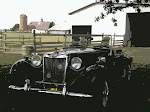


Kingston, Tennessee to Home
Our adventure today was to explore the area of Kentucky where Betsy’s Frye family lived. Instead of roaring up I-75 like we normally do we got off at London, went west to Somerset and then north on KY 127 headed to Liberty. Just north of Liberty in a nice little pull off park there is a Kentucky State Historical Society roadside marker dedicated to John Frye, Betsy’s patriot ancestor. John Frye had a short but amazing life. John was born in 1754 in Frederick Co, VA but eventually moved into Kan-tuck. He fought in the Battle of Point Pleasant (Oct 10th, 1774) in what is now West Virginia. Most historians consider the Battle of Point Pleasant to be the opening battle of the American Revolution.
After the battle John returned to his home and in 1780 he petitioned for a land grant on Carpenters Creek in what is now Casey Co, KY. The Indian threat persisted now with the full knowledge and support of the British. Small frontier settlements were being attacked on a regular basis. In one instance Bryant's Station, near Lexington was attacked and the militia was called out to follow and engage the Indians. One hundred and eighty two men responded. Included was John Frye, Daniel Boone, and Daniels son, Israel. When the militiamen caught up with the Indians Daniel Boone saw that the Indian’s were not following their usual methods of concealment or covering their tracks, and he suspected that he and the others were being lead into a trap. Unfortunately he could never convince the leaders of the militia, and as Daniel suspected, the militia walked squarely into an ambush on August 19, 1782. What was unknown to the militiamen was that in addition to the three hundred Indians there were also fifty British Rangers waiting for them. Of the 182 militiamen only a few survived. Among the dead were Israel Boone, and John Frye at age 28.
All of the casualties were buried at the battlefield. Years later a monument was erected listing the names of all who fought and to honor those who died.
The ambush came to be known as The Battle of Blue Licks and it occurred ten months after the British surrender at Yorktown. It is considered to be the last battle of the American Revolution. John Frye may be the only individual that fought in both the first and last battle of the American Revolution.
After taking a few pictures of the historical marker we continued north on 127 in an attempt to find Carpenters Creek. We thought we had found it and took a road west which seemed to follow the creek. After about a mile we ran into a sign saying,
Frey’s Creek Baptist Church. We then saw on some mailboxes that the little road we were on was Frey’s Creek Road. We left the paved road, and went down to the church. At the church there was a small bridge that spanned the creek and beyond the road turned into gravel single lane. We continued to follow it, with Frey’s Creek right next to us. We rounded a curve, and low and behold the creek bed and the road became one in the same for about 200 feet. Even though we were in the Nissan
we elected to go forward and we made it. About a quarter of a mile further the road ended at a couple of houses. We retraced our steps back to the main highway and headed north again, looking for Carpenters Creek. Just before the Lincoln Co line Betsy saw a road sign for Carpenters Creek Road. It was basically a grass path.
We drove down to the creek and maybe 100 yards further. I figured we had done enough off roading for the day, and we backed out. I feel sure that we saw some land that John Frye would have seen in his short life.








